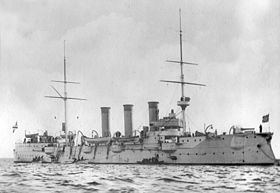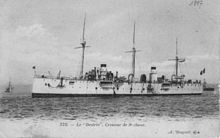Boyarin
|
|
|
|---|---|
 Boyarin |
|
| Overview | |
| Type | Protected cruiser |
| units | Single ship |
| Shipyard | |
| Order | 1899 |
| Keel laying | September 24, 1900 |
| Launch | June 8, 1901 |
| delivery | September 1, 1902 |
| Namesake | Russian for landlord / nobleman |
| period of service |
1902–1904 Russian Navy |
| Whereabouts | Stranded and shattered February 12, 1904 after being hit by mines off Dalian |
| Technical specifications | |
| displacement |
3,200 t , |
| length |
105.02 m |
| width |
12.05 m |
| Draft |
4.88 m |
| crew |
331 men |
| drive |
16 Belleville boilers |
| speed |
22 kn |
| Armament |
• 6 × 120 mm L / 45 Canet -Geschütze |
| Bunker quantity | |
| Armor |
|
The Boyarin ( Russian Боярин , squire, nobleman ) was a protected cruiser of the Imperial Russian Navy , which was designed and built in Denmark in the Copenhagen shipyard Burmeister & Wain . It was a parallel development to the Nowik ordered in Germany . At the beginning of the Russo-Japanese War , she was stationed in the Far East. It was lost to a mine hit on the third day of the Russo-Japanese War .
Planning and construction
As part of the “Shipbuilding Program for the Needs of the Far East”, four protected cruisers of the second rank were also to be built for reconnaissance, instruction and support tasks and the fight against torpedo boats. The Naval Technical Committee received a lot of information and decided on the design of the Schichau-Werke , which led to the Nowik and the replicas of the Isumrud class . At the same time, on April 15, 1899, he placed the order for the boyarin , although the Danish project only met the committee's wishes to a limited extent. It is believed that the Tsar's mother , Maria Fyodorovna , a Danish princess, convinced him to order a cruiser for the Russian Navy in her home country.
The main disadvantage of the Danish project was the uncertainty about the longitudinal strength of the ship. The attempts at improvement increased the displacement from 2,600 to 3,075 tons and reduced the speed. In addition, the cruiser was more expensive than the Nowik , since higher wages were paid in Denmark and many individual parts had to be obtained from the Danish shipyard abroad. The keel was officially laid on September 24, 1900, after a Russian construction officer had been stationed in Copenhagen at the beginning of September. On May 26th / June 8th, 1901 the Bojarin was launched . Captain Vladimir Fyodorovich Sarychev , who had previously participated in the suppression of the Boxer uprising in China, was appointed to command the ship . He supervised the completion of the cruiser and praised the construction by the Danes. In June 1902, the factory test drives began under the Danish flag. There were strong vibrations of the hull from a speed of 14 knots.
Service before the war
On September 1, 1902 (August of the Russian calendar) the boyarin was taken into service. On October 19, 1902, the cruiser moved under the command of Sarychev to Kronstadt , where it arrived on October 21. Just two weeks later he was assigned to the association of Rear Admiral Stackelberg , which should strengthen the Pacific squadron . The core of the association were the ships of the line Retwisan and Pobeda with the first class cruisers Pallada and Diana . The cruisers Askold and Nowik , which were already on the march, as well as the Bogatyr - all three of which were made in Germany - were included in the association, as were seven torpedo boats that were relocated to East Asia. However, the association was probably never closed together. Exercises were carried out between Algeria and Crete, some with French participation.
The boyarin followed the union of the two ships of the line and the three cruisers , which was leaving via Libau, on November 9th from Kronstadt and ran straight to Copenhagen to have some repairs carried out at the shipyard. In unfavorable wind conditions and swell up to force five, she covered 697 nm in 51.5 hours (13.5 kn). At the end of November she joined the formation in Portland and ran to Vigo to bury the ship's chief engineer, who had shot himself for unknown reasons shortly after leaving Portland. In the Mediterranean, the association fell apart a little because repairs were required on various ships and the torpedo boats were also used to form the association.
The boyarin was ordered to run into the Persian Gulf and demonstrate Russia's political interests. On 6./7. In February 1903 it passed the Suez Canal . It was the fourth voyage of a Russian warship in this area of the sea. The gunboat Giljak in 1900, the cruiser Varyag in 1901 and the Askold in December 1902 had made similar trips on their trips to the Far East. The British government reacted negatively and refused to provide coal. It was therefore agreed to cooperate with the French station ship Infernet , with whom Boyarin met on February 12, 1903 in Djibouti to carry out the journey together. On February 17, the two cruisers left, first visited Muscat and then ran in a strong storm to Bushehr , where they stayed for five days and the boyarin was able to add 200 tons to the coal supply. This was followed by Kuwait with a three-day stay, Lingeh , Bandar Abbas and again Muscat, where the two cruisers stayed for three days. The British cruiser Perseus observed the activities of the two cruisers. On March 17, the boyarin separated from her French companion before she entered Karachi on March 19 .
After a four-day stay and taking over 300 tons of coal, the boyarin ran to Colombo in 131 hours , where she met the Bogatyr on March 28 . After three weeks of overhaul, supply and rest, she ran with the Stackelberg Association on April 16 to Sabang , Singapore and, deviating from the flagship Retwisan, via Shanghai to Port Arthur , where she arrived and was stationed on May 24, 1903.
She then took part in the maneuvers of the Pacific Squadron in the Yellow Sea and its trips to Vladivostok . It was praised by Viceroy Alexeev for its economical coal consumption. In December 1903, was Bojarin as stationary after following the intensification of the military-political situation Chemulpo sent. In early January 1904 she was replaced by the Varyag and ran to Port Arthur.
Russo-Japanese War
During the first Japanese attack on Port Arthur on the night of February 8th to 9th, 1904, the boyarin was not damaged. She ran out relatively late with the other cruisers. They almost attacked the incoming Russian torpedo boat Silnyi , which had no knowledge of the outbreak of war. On the evening of the next day the boyarin received the order to accompany the mine-layer Yenisei , who was to lay the last minefields to secure Port Arthur in the Bay of Dalian , but later ran into its own mine and was the first Russian warship to be lost. Destroyers were dispatched to clarify the situation, as it was assumed that the Japanese fleet would attack again from the land. Later the boyarin ran into a mine, whereupon the crew left the ship and went to the destroyer. The next day the torpedo boats were Wynosliwy and Grosowoi sent into the bay of Dalian. They found the cruiser, which had now run aground, and believed that it could be removed. It should begin the following day. During the night, the Boyarin was driven on in the storm and was probably damaged again by other mines. The boyarin was driven in an inaccessible place, so that recovery was no longer possible. Their commander, Sarychev, was found guilty of leaving the cruiser prematurely.
Web links
- AV Skworzow: Cruiser II. Rank Boyarin (Russian)
- Boyarin on narod.ru (Russian)
- Bojarin on nashflot.ru (Russian)
- Bojarin on navsource.narod.ru (Russian)

